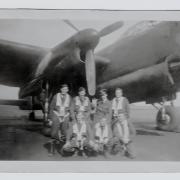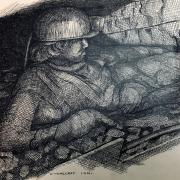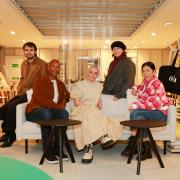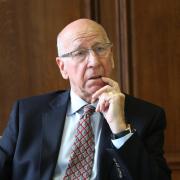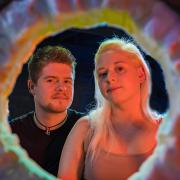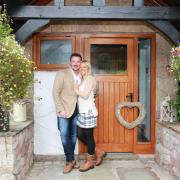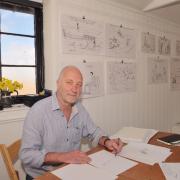Discoverer of the neutron, which would become a key component of the atomic bomb, first used in anger a decade after Chadwick received his Nobel prize.
Cheshire-born Nobel Prize winners are rare, like sightings of Dartford Warblers. There have only been three to my knowledge, one of whom was Sir James Chadwick (1891-1974), who was awarded the 1935 Physics Prize after discovering the neutron.
The only trouble with boffins is they can sometimes open the Pandora's Box (in Greek mythology opening the box unleashed curses upon mankind). History now tells us that, in fact, Chadwick's discovery prepared the way for the fission of Uranium 235 and towards the creation of the atomic bomb.
James Chadwick was born in Bollington, a town overlooked by a monument to war. Up on Kerridge Hill is Grade II Listed White Nancy, erected in 1817 to commemorate Wellington’s victory at Waterloo.
It’s a sentinel that would have been familiar to the young Chadwick who grew up in the town and attended Bollington Cross School. I can imagine him clambering up the hill to look at the folly. The words war and folly coalesce and it was the well-intentioned Chadwick would ultimately be responsible for more icons of war.
James’s parents were John Chadwick, a cotton spinner, and Anne Knowles, a domestic servant, so the future Nobel Laureate was definitely not born with a silver spoon. He was named James from his paternal granddad but it was his maternal grandparents who figured prominently from 1895, the year John and Anne moved to Manchester, leaving their young son behind.
James must have taken the family upheaval in his stride as he did well at Bollington Cross; so well he was offered a scholarship to Manchester Grammar, which he was unable to take up as the family couldn’t afford the fees. He attended the Central Grammar in Manchester instead and reunited with his parents, by which time he also had a couple of younger brothers, Harry and Hubert. Come 16 the bright working-class lad from Cheshire had gained a university scholarship.
Chadwick studied at Manchester, Berlin and Cambridge, graduating from the Victoria University of Manchester (part of Manchester University today) in 1911. Here, he had studied under the legendary Ernest Rutherford (1871-1937), dubbed the ‘father of nuclear physics’, and continued to do so until 1913, when he received his MSc.
Berlin beckoned next, where Chadwick studied beta radiation under the renowned Hans Geiger (1882-1945), he of the ‘Geiger counter’. Chadwick was in Germany when the Great War broke out and spent four years in the Ruhleben internment camp. Around six miles west of Berlin, the camp detainees included naturalised citizens of the Allied Powers who were in the wrong place at the wrong time.
With the war over, Chadwick returned to the UK, where he resumed his collaboration with Rutherford, this time at Cambridge’s Cavendish Laboratory. It was during his Cambridge sojourn that Chadwick obtained his PhD (1921), as he attained the highest academic level. Chadwick was Rutherford’s assistant director for more than a decade at a centre at the forefront of physics research.
Chadwick worked on radioactivity and discovered the neutron in 1932, the breakthrough that saw him honoured with the Nobel Physics Award. At this stage, despite the Great Depression, there was still something of a false optimism. Chadwick looked at neutrons as trailblazers in the fight against cancer. But when Hitler came to power in Germany in 1933, thoughts turned from peace and medical science to preparations for war and weapons of mass destruction.
In 1935 Chadwick left Cambridge and headed back to the northwest, becoming professor of physics at the University of Liverpool, where he installed a cyclotron (a particle accelerator), which helped to make the university a major centre for the study of nuclear physics.

You may have heard of particle accelerators, specifically the Large Hadron Collider (LHC), which is the world’s largest and highest-energy particle collider. It’s situated beneath the French-Swiss border near Geneva, built by the European Organisation for Nuclear Research (1998-2008), sitting in a tunnel that has a staggering 17-mile circumference and four crossing points where the accelerated particles collide.
The facility tests the predictions of the various theories of particle physics. It’s complex stuff and even the brightest boffins of the past, like Chadwick, probably didn’t see this coming. Not on such a scale anyway.
During WW2 Chadwick was engaged in something far less humanitarian than cancer research. He was employed in the Tube Alloys project, an R&D project authorised by the UK government to develop atomic weapons during the war.
This got underway before the more famous Manhattan Project in the States and was highly classified, hence its rather misleading name of Tube Alloys, suggestive of something far more benign. With the UK being bombed it was difficult to maintain such a project here so it was merged with America’s equivalent courtesy of the secret Quebec Agreement of August 1943.
Chadwick’s immediate future now lay in the States where he worked in both the American capital, and at the Los Alamos Laboratory (or ‘Project Y’), in New Mexico – a covert laboratory set up by the Manhattan Project. Its mission: to develop the world’s first deployable atom bombs.
The first director was J. Robert Oppenheimer (1904-67) the American theoretical physicist and the project director was Leslie R. Groves Jr. (1896-1970), a US Army Corps of Engineers officer who not only directed Manhattan but also oversaw the construction of the Pentagon. For his contribution, Chadwick was rewarded with a knighthood in the New Year Honours of January 1945. By that point, the atom bomb project was entering the final strait.

In the early morning of July 16th, 1945 Chadwick was a witness to the Trinity test, which occurred in the desert in New Mexico. The first atom bombs were then dropped on Hiroshima (August 6) and Nagasaki (August 9) to bring the conflict to an end. The Fat Boy detonated above Hiroshima by the Enola Gay bears a spooky resemblance to White Nancy, which glowers down on Bollington: Two bomb shapes bookending the story of James Chadwick.
Chadwick later served as the Master of Gonville and Caius, Cambridge (1948), his former alma mater. He retired in 1959 and was created a Companion of Honour in 1970. He died on July 24th,1974 aged 82. Some people may question whether a member of the Manhattan Project should be considered a ‘Great’.
Chadwick would have understood the ironies: how the discovery he hoped would attack cancers led to radiation-induced ones in the aftermath of Hiroshima and Nagasaki. When Chadwick realised what was possible (nuclear weapons), he: ‘had then to take sleeping pills. It was the only remedy’.
We should be under no illusions though. Hitler would have been happy to use any superweapons at his disposal. The launching of V-2 rockets against Allied cities was the first long-range guided ballistic missile to be deployed.
It was a race to develop the bomb. After the war, the atom bomb was superseded by the nuclear warhead, many times more powerful than the weapons used in 1945. An uneasy standoff ensued between the nuclear powers with no one wanting to risk World War Three. Perhaps we have something to be grateful to Sir James Chadwick for after all.
THE OTHER CHESHIRE-BORN NOBEL PRIZE WINNERS
1917 – Charles Barkla (1877-1944). Born in Widnes. The Physics Prize.
2001 – Sir Tim Hunt (1943-). Born in Neston. The Physiology or Medicine Prize.
CHRONOLOGY
1891 – James Chadwick born in Bollington, Cheshire (October 20).
1911 – Graduation from the Victoria University of Manchester.
1914 – Imprisoned in the Ruhleben internment camp during WW1.
1925 – Married Aileen Stewart-Brown from Liverpool. They had twin daughters.
1932 – Chadwick’s great achievement: the discovery of the neutron.
1935 – Awarded Nobel Physics Prize and becomes professor at University of Liverpool.
1943 – Chadwick joins the Manhattan Project after the Quebec Conference.
1945 – James Chadwick is knighted a few months before the first atom bomb test.
1946 – Chadwick returns home and becomes adviser to the UN Atomic Energy Commission.
1974 – Death of Sir James Chadwick in Cambridge (July 24) aged 82.






